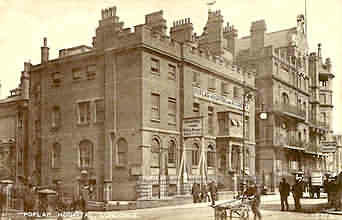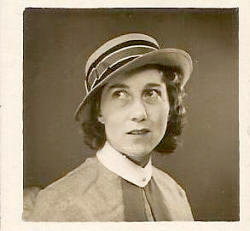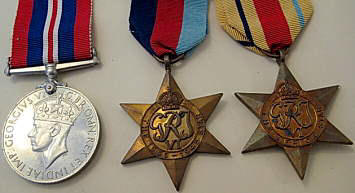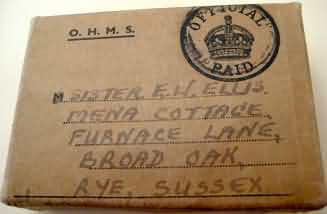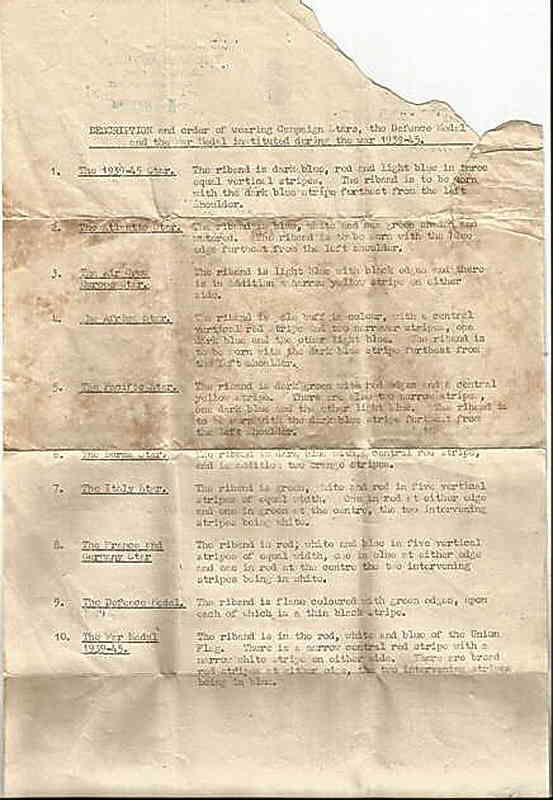|
Collecting Nursing History 27 NURSE ELSIE WINIFRED ELLIS - NEE OSMOND 1912-2005. Sarah Rogers. |
 |
Please Note: Whilst every care is taken in checking promoted links, we cannot accept responsibility for your use of third party web links. | |||||||||||||||||||
Hospital badges
awarded to Nurse Elsie Osmond on completion of her SRN training in
1939
copyright, Karen Harris I became interested in Poplar Hospital having worked as a District Nurse Student and District Nurse in Poplar/The Isle of Dogs, usually either cycling and walking around the area (unless the pool car - a bright orange mini was available into which we could cram a commode in an emergency) thus giving me time to absorb the historic buildings. Elsie Winifred Ellis, nee Osmond trained at the Poplar Accident Hospital from 1935 -1939. A group of her medals and training school badge were sold at auction recently, without her GNC badge. The GNC indexes led to her registration details at Kew. Elsie's GNC number was 98828 and her address then was 93 HILLINGDON RD , BARNEHURST, KENT ,her registration date was 23.6.39, and her training was confirmed as at Poplar Hospital, by examination. (3)
POPLAR HOSPITAL FOR ACCIDENTS/ POPLAR HOSPITAL 1855 -
1975 Its purpose was to treat trauma patients initially; male workers injured in the East & West India Docks-and later Millwall Dock. Samuel Gurney (1786-1856) a Quaker banker and Money Wigram (1790-1873), a Blackwall shipbuilder and ship-owner, decided that a local hospital was a necessity after a seriously injured labourer died on route to the London Hospital in Mile End *- the nearest hospital to the docks. Both Gurney and Wigram were connected to the London Hospital and in 1854 had suggested that the proposed hospital in Poplar should be attached to the London Hospital, but this was not acceptable. This possibility was raised again in 1868, but with no effect. * The London Hospital , Whitechapel was 2.0 miles, and Mile End hospital was 2.2 miles from Poplar , it is assumed that the source used is referring to Whitechapel, as they did not merge until 1974,(when Mile End Hospital became known as the London Hospital, Mile End). By 1870 as activities in the docks had greatly declined there were fewer causalities, so Poplar Hospital began to accept medical cases for treatment. An Out-Patients wing was added in 1880 . In 1886 the Hospital purchased the freehold of the site from the East and West India Dock Co. In 1890 two houses in East India Dock Road were bought. In 1892 Queen Victoria became an annual subscriber and a life governor, thus increasing the level of funding. In 1894 women and children were able to be admitted for the first time after a 4-storey wing was completed which contained three floors of wards and Out-Patients Department was relocated to the basement. The Hospital was extended further in 1899, with an isolation block being built at the back of the site. A new wing five and a half storeys high was erected to the east of the 1894 wing. The Hospital was now able to provide general treatment facilities for the Poplar district. After an agreement with the LCC, in 1910 the Hospital began to undertake the dental care of schoolchildren and also in 1910 approximately 345 workmen, injured during the building of the 'Thunderer', a Dreadnought-class battleship, at the Thames Iron Works, also received treatment. During WW1 the Hospital was linked to the Fourth London General Hospital,( formerly the Maudsley Memorial Hospital, Denmark Hill) and 24 of its beds were reserved for military casualties. being beside the docks the Hospital buildings suffered from Zeppelin raids, many being badly damaged. On 19th January 1917 it received casualties from the Silvertown explosion, when 50 tons of TNT exploded at a chemical works. Sixty-nine people were killed and 450 injured-fourty people were admitted, of whom 7 died. Rebuilding continued after WW1 until 1929. The Hospital was extended at the rear ; the 1881 west wing was demolished and rebuilt in 1922, and a children's ward, a Nurses' Home and a mortuary were added. A new operating theatre was also installed in 1929. When Elsie joined a further building programme was in place;in 1934 a larger Out-Patients Department was built, which extended northwards. An extra storey was added to the original 1894 east wing during 1936-37. In 1937 the Hospital finally dropped the words 'for Accidents' from its name - it had been a general hospital for over 20 years. During WW2 the original main building was destroyed by bombing in 1941. A number of people were killed and the Hospital closed for a short time. In 1948 the Hospital joined the NHS, under the control of the Bow Group Hospital Management Committee. By 1950 the original Hospital had been mainly replaced by more practical buildings, but with the decline of the inner London docks it became obsolete. Following closure in 1975 and, despite protests from the local residents, who wanted to keep the buildings for community use, it was demolished in 1982. (1)
Elsie appears to have signed up almost immediately on the completion of her training, which coincided with the start of war.(4) She joined the Queen Alexandra's Nursing Service Reserve, being attached to the 5th General Hospital. Elsie disembarked in France on Monday November 13th 1939 and is shown on 19th January 1940 in the field returns as a staff nurse still attached to 5th General Hospital, QAIMNS, British Expeditionary Force. (2) In the war diary held at Kew much is made of nursing staff obeying regulations; in particular to uniform (when out in public) and marriage. In a letter sent to all Matrons and Sisters of QAIMNS a letter is sent from the Principal Matron, K.H. Jones from H.Q. in Dieppe on 16th December 1939 to remind them of uniform regulations:
For many young women joining up , the restrictions and rules mentioned may have seemed more draconian that those they had been subject to whilst training in civilian hospitals at home. Or perhaps it was the sense of freedom , mixed with very real danger that led to some of these young women pushing the boundaries. One nurse is sent home in apparent disgrace, the only reason being that she had forgotten to tell them that she had married her fiancé as he went off to war. The nurse in question was immediately sent home to England with strict instructions that she was not to nurse!
Another nurse also tenders her resignation , before her return to her unit(No 5 General Hospital);
Luckily, both these young women appear to not to have become widows during the war, although their husbands may well have suffered life long trauma due to serving in WW2. Towards the end of the War Diary, whilst very little is said about danger, there are references in it to all papers being burned and equipment destroyed;
Elsie and her colleagues embarked in the UK from the 'SS Bruges" on Saturday 25th May1940, 2 days before the evacuation of troops from Dunkirk.
A book about this period records ; Without Elsie's war record (sealed for 25 years after her death - unless a family member were to request it) her movements after arriving back in England during Dunkirk cannot be tracked. However from GRO records a marriage is documented between Elsie W Osmond and a Mr. Ralph Ellis in Cairo between 1941-1945. The GNC register which had annotated in red beside her name; "MARRIED 19.7.1941" (3) A Ralph Ellis appears to be her husband, and he travelled out to Port Said, Egypt from Liverpool in September 1935 on the S.S.Gloucestershire, giving his occupation as a teacher. It also appears that Elsie had continued to work after her marriage in the army - perhaps the need for nurses was altering previous conventions about unmarried nurses? Certainly this was an issue elsewhere among countries involved in WW2.
Marriage whilst in service. Army Women-Early in the war, marriage policy for Army nurses changed when the War Department lifted the ban on marriage for nurses. The new policy allowed them to remain in service–at the discretion of the Surgeon General–for the duration of the war plus six months." (6) Similarly in November 1942 it is reported in Australia ; "MARRIED ARMYNURSES - Removal Of Ban CANBERRA, Friday. - The virtual ban on the marriage of Australian Army nurses has been lifted by amending military regulations issued today. Formerly Army nurses who married or were found to be married had to be discharged. It is now provided that the services of married nurses may be retained at the discretion of the Director-General of Medical Services, provided their marriage does not interfere with the performance of the nurse's normal duties." (7) By May 1947, Elsie is back in England and living in Rye, Kent, to where her medals are sent.
War Office letter describing the Medal awards.
"REG FEE UNPAID, REMOVED 28.1.49"..perhaps in the haste of joining up she had forgotten her fee? But a further entry states "REINCLUDED 14.11.55" Elsie appears to have had at least one child, a girl who appears to be living , it may be that she returned to work after this in 1955. Staff records are closed for at least 80-100 years from the last entry, so it may be many years before more can be found out about her career and life . Elsie died in 2005, in Rolvendan Layne, a hamlet near Cranbrook in Kent. References 1.http://ezitis.myzen.co.uk/poplar.html 2.The National Archives, Kew, WO177/1120, War Diary No 5 General Hospital 1940. 3. The National Archives, Kew, DT10/80 4. http://www.findmypast.co.uk/ 5. Grey and scarlet : letters from the war areas by army sisters on active service [Hardcover]Ada M. Robert Austin (ill.) Harrison (Author) 6. Mary T. Sarnecky, A History of the U.S. Army Nurse Corps (Philadelphia: University of Pennsylvania Press,1999), 181, 453. 7. The Mercury (Hobart, Tas. : 1860 - 1954) (about)Previous issue Saturday 21 November 1942 |
SECTION
1 Schools of Nursing. SECTION 2 |
||||||||||||||||||||
| Home Schools Region Forum Collecting Galleries History Bibliography News Archive Contact |


